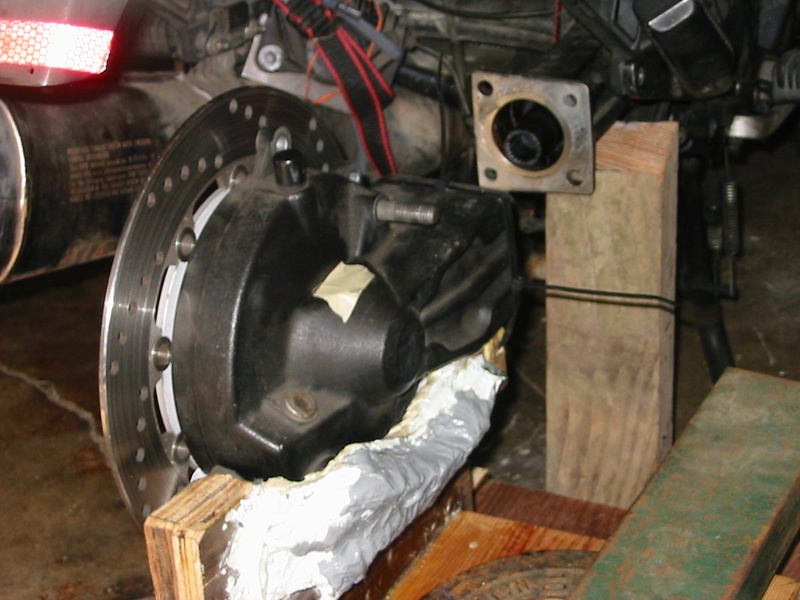1

 Final Drive Spline Lube Cradle Fri Sep 02, 2016 2:46 am
Final Drive Spline Lube Cradle Fri Sep 02, 2016 2:46 am
knave
active member


The tool I built can be described as a final drive stand, or a jig, a cradle, and a dolly. It is an aide in all the three steps of servicing the rear splines of a mono-lever K bike like mine:
Step 1 -- Remove final drive from drive shaft.
Rear wheel has already been removed, brake calipers secured, and rear portion of speedometer cable disconnected and secured.
The stand/cradle attaches to the final drive with two plastic 12 inch zip ties before removal. After the shock absorber is unbolted, the four Allen bolts connecting the final drive to the drive shaft are removed. The stand, with the final drive mounted upright, is then rolled down the ramp which has the same slope as the drive shaft in its running position. The stand in no way replaces the need to prop up or strap the drive shaft in position before disassembly.
Step 2 – Cleaning, inspection, and lubing the splines themselves. This is the most important step. With the final drive upright and secure in the stand/cradle, this phase can be done as thoroughly as needed without the risk of kicking over a final drive leaning shakily against the wall while it sits on the garage floor. An old toothbrush and solvent are good for removing old lube material, often high in molybdenum disulfide paste, a popular ingredient for lubricating splines. After cleaning both input and output splines I apply a generous amount of fresh lubricant/paste with on old 1 inch paint brush that has that has lost most of its pliability.
Step 3 – Reassembly. Here is where you need a third hand to spin the brake rotor slightly so the output and input splines mate and slip into place. An unsupported final drive is heavy and awkward to hold and guide, requiring both hands for many of us. But with the final drive on the stand/cradle, which is sitting on the ramp, one hand is enough. The other hand is used to spin the brake rotor.
The final drive has a beveled shape with few flat surfaces to use when molding a jig. I did it in many steps. I cut out wood and metal, bending different gauges of wire to match the bevel. I then covered the bent wire with fiberglass cloth and multiple layers of epoxy resin and filler. With great care I avoided contaminating the final drive exterior(or interior) with uncured epoxy.
The sheet metal inner surface of the stand, facing the brake rotor, must be completely flat and smooth, so as not to damage the rotor in motion. Look for a groove at the bottom of the cradle where the final drive drain plug fits undisturbed.
Construction of the tool required a lot of work. A 3D printer might provide a means of reproducing the molded cradle portion of this project. The other parts are not that hard to build and I expect there are riders who could offer improvements.


Last edited by knave on Fri Sep 02, 2016 2:51 am; edited 1 time in total (Reason for editing : add view showing contact area of cradle)














